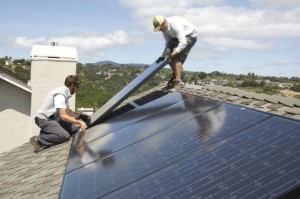California now has 1 GW of installed rooftop solar

Installations of rooftop solar in California are booming, even in the middle of a nasty recession. The state just reached 1000 MW (1 GW) installed statewide, with 205 MW of that in 2011 alone. This cumulative total is more than all but a few countries. Primary among the reasons are the rapidly falling price of photovoltaic solar, the popularity of leasing solar systems (which requires no money down), and rebates from the state.
The state pays residential solar rebates in a one-time upfront fee. If a homeowner contracts with a solar leasing company like Sungevity, then the company gets the rebate, installs solar on the roof and pledges to maintain it. The homeowner pays a fixed monthly lease for the solar and presumably has much lower electricity bills since they will be paid for sending unused power into the grid. Thus, their total power costs over time will be less. The company maintains the system and replaces any parts as needed.
But this isn't just for homeowners. A combined state effort, Go Solar California, also has programs for businesses, farms, and governments. They are well on their way to a goal of 3 GW of installed rooftop solar by 2016 and are a "one-stop shop" for information on solar programs, tax credits, and rebates, as well as technical information on installing and interconnecting.
So, how much is a gigawatt? A gigawatt (GW) is 1,000 megawatts (MW), which in turn is 1,000 watts of generating power. Of course no power plant can ever match its rated power over time because it will be down for maintenance or, in the case of renewables, the sun isn't shining or the wind has stopped blowing. The San Jose Mercury News says a gigawatt is about the size of two coal plants and could power 750,000 homes. These numbers would seem to underestimate both the size of coal plants and the number of homes. While coal usage is dropping, it is still by far the biggest producer of power in the US, with quite a few coal plants over 2 GW. The latest number I could find was an average of 667 MW for coal plants. As for electricity needed per household, a primary factor is how much air conditioning is used. The Department of Energy estimated California monthly power usage in 2009 at a surprisingly low 580 kWh per home, much less than the national average of 908. Using that number, then 1 GW could power 1.72 million California homes (many of which presumably are not in hot areas that require extensive air conditioning.)
California rooftop solar has the potential to power a substantial amount of the state. However, to do this, a smart, modern grid is needed. It needs to be able to handle, say, Los Angeles rooftops generating 2 GW on a hot August day then dropping to zero almost instantly should clouds pass in front of the sun. Plus, the power will be coming from everywhere, not just a few, well-defined huge power plants. Chief among what is needed is the ability to store power then use it instantly.
California clearly leads the nation (and all but a few countries) in solar power. Let's hope the trend continues.



